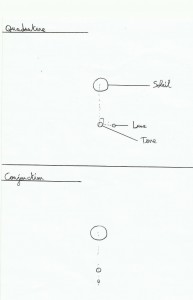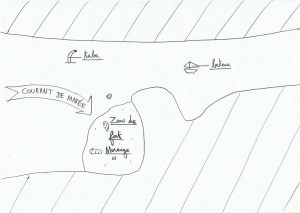All celestial bodies which are interacting each other via the gravitational attraction(see Newton's laws)create tidal forces, Moon exerts on the Earth a tidal force, but the other way is also true, even more substantial because this force has made the moon rotation period equal to its period of revolution(28 days roughly, that's why it's always the same face of the moon that is shown). Earth's attraction has finally “braked” the rotation of the Moon in some ways, So it is quite easy to guess the future: attraction's force of the Moon will also brake the rotation of the Earth, gradually lengthening day's length(the earth wins 1 second of delay every 600 centuries).
1)Quadrature and Syzygie
The celestial bodies that have significant gravitational influence on Earth are the Sun and the Moon, so both come into the game in the tides. The Sun represents one third of the total tide's strengh and moon two thirds remaining. Their effects are added when they are in line with the Earth(conjunction or Syzygie)and interfered when they are in quadrature(they draw an angle of 90 ° with the Earth).
Basically when there is conjunction, when we are on a new moon or full moon tides are strong, and when we are in quadrature(first or last quarter)tides are weak.
The sun's zenith is located in equatorial area, and the Moon has an orbit close to the ecliptic(5° of the ecliptic), we deduce that this force is applied mainly on the equatorial water masses. Offshore the water displacement is small, but it becomes important on the coast with a weaker depth.
Notice: the equinoctial tides are mainly due to the Sun at this time because it exercises on water equatorial masses a maximum force.
Earth turn on itself in 24 hours, So there is about two high and low tides at a point of the globe on the same day. The moon takes 28 days to turn around the Earth in the anti-clockwise(like Earth)therefore at a point of origin the earth tide shifts of 1/28 th Day, 52 minutes(between two low tides for example there will be approximately 12 hours 26 minutes).
2)Effects
The effects caused by this phenomenon can be felt near the coast. The more water is low in depth, the more water level will change, the more we are close to the equatorial zone the more its influence is felt, the more the coast tightens, the more it will change the water level . The tide phenomenon is almost nonexistent in enclosed seas because these water masses are less important in quantity.
Examples: the very weak tide in the Mediterranean sea, in the contrary very strong in the Channel due to the short depth of it(70 meters max )compared with Atlantic, to the funnel shape of the Channel and angular coast between Brittany and the Hague cape that “traps” Water, and furthermore Coriolis influence.
Yes..., this is supposed to be the Channel…Like the wind, currents are deflected to the right in the Northern Hemisphere, the tidal range is the difference in water level between high tide and low tide.

